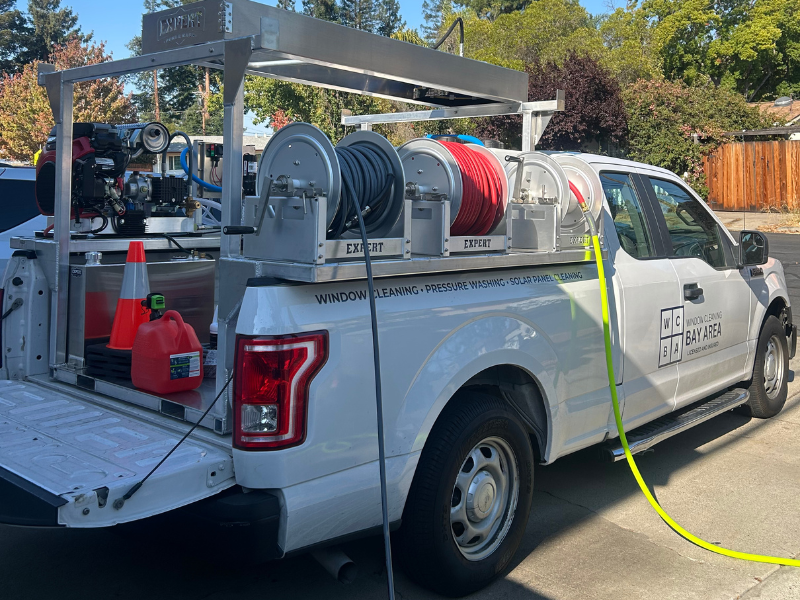

When it comes to keeping a home’s exterior looking its best, two professional cleaning methods dominate the industry: pressure washing and soft washing. At first glance they may seem similar, but they are very different techniques, and using the wrong method can lead to costly damage. Understanding the difference between them is the first step toward protecting your property and keeping it looking clean year-round.
Pressure washing uses high-pressure water, often exceeding 2,500 PSI, to strip away dirt, grime, and stains from hard surfaces. This method is best suited for durable areas such as concrete driveways, sidewalks, pavers, and brick patios. The sheer force of the water can lift years of built-up debris and restore surfaces that may have looked permanently stained. When used correctly, pressure washing can extend the life of hard materials and dramatically improve curb appeal.
Soft washing, on the other hand, relies on low water pressure combined with specialized cleaning solutions. These solutions—usually a carefully mixed formula of sodium hypochlorite and surfactants—do the heavy lifting by breaking down organic growth such as mold, algae, moss, and mildew. Because soft washing depends on chemistry rather than brute force, it is safe for delicate surfaces like siding, stucco, painted wood, and especially roofing materials. A roof, for instance, can be ruined by high pressure, but a proper soft wash kills moss and algae at the root while protecting the shingles.
The key difference between the two methods comes down to pressure versus chemistry. Pressure washing removes surface-level dirt and stains through force, while soft washing sanitizes and restores by killing organic growth and gently rinsing it away. For a homeowner, the risk comes in applying the wrong method to the wrong surface. Blasting a roof with high pressure can tear off shingles, force water underneath, and even void warranties. Using a low-pressure soft wash on a driveway, on the other hand, won’t be effective against oil stains or hardened grime.
Professional exterior cleaning companies make the distinction based on surface type, condition, and the kind of buildup present. A concrete driveway with deep oil stains calls for pressure washing. A vinyl-sided house with algae streaks calls for soft washing. Often, the two methods are combined during a full-property cleaning. For example, a crew may pressure wash the driveway and patio while soft washing the roof and siding, ensuring every part of the property gets the treatment it needs.
The benefits of choosing the right method go beyond appearances. A clean home exterior increases curb appeal immediately, but it also prevents long-term damage. Algae and mildew, if left untreated, can eat away at siding and roofing materials, leading to costly repairs. Mold spores can also affect indoor air quality, so removing them from exterior surfaces improves the health of your living environment. On the hard surface side, regular pressure washing prevents deep staining and keeps concrete and brick from deteriorating prematurely.
Homeowners often ask whether they should try to do the work themselves. While renting a pressure washer might sound like a quick solution, many DIY jobs result in uneven cleaning, damage to siding or paint, and even injury. Soft washing requires specialized equipment and precise chemical ratios that most homeowners don’t have access to. In contrast, hiring a licensed and insured professional ensures that each surface is treated with the right method, the right solution, and the right level of care.
So how often should you schedule exterior cleaning? In most cases, once every 12 to 18 months is ideal. Homes in shaded or humid areas may need it more frequently because algae and mildew thrive in those conditions. Roofs in particular benefit from preventative soft washing every couple of years, while driveways and patios exposed to heavy use may require pressure washing on a more regular schedule.
Keeping your Bay Area home’s exterior clean is more than just about looks—it’s about protecting your investment. With our local climate, homes in cities like San Jose, Los Gatos, Saratoga, and the surrounding areas often collect dust, cobwebs, algae, and moss faster than expected. That’s why knowing the difference between pressure washing and soft washing is so important. Using the wrong method can cause damage, while using the right one restores curb appeal and extends the life of your property.
Pressure washing is the most effective way to clean hard surfaces such as concrete driveways, brick patios, and paver walkways. It blasts away dirt and stains, leaving behind a fresh surface. Soft washing, by contrast, is the safest choice for roofs, siding, and delicate materials, because it uses low water pressure paired with cleaning solutions that kill organic growth like algae and mildew at the root. Bay Area homeowners who combine both methods can keep their entire property looking new year-round.
Hiring a professional in the Bay Area ensures your home gets the right treatment every time. Our team knows how to protect your property while delivering results that last. Contact us today for a free estimate and see why so many Bay Area homeowners trust us to keep their properties looking their best.